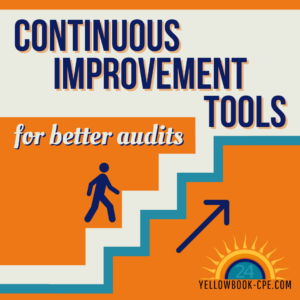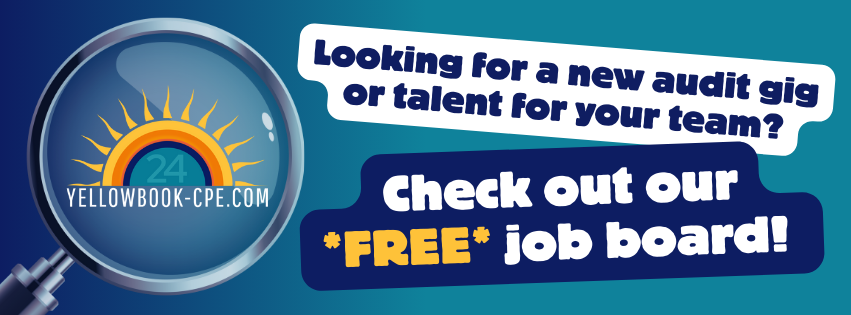Special thanks to Alfredo Mycue and Susan Oballe, our brilliant instructors for the upcoming webinar on Continuous Improvement Tools for Government Auditing for allowing Yellowbook-CPE.com to republish this valuable article.
Why should auditors have an interest in continuous improvement methods?
Because you care, that’s why.
Auditors have a professional interest in enabling the audited program to achieve its goals and conquer the challenges currently constraining the organization. We argue here that auditing methods identify these challenges. They also provide management tangible tools and implementable methods to decisively improve the auditee.
A synthesis of established continuous improvement approaches, like Lean and Six Sigma, with new process improvement approaches of the Theory of Constraints, Agile IT, and learning science offers the promise of transforming the current approaches to auditing. This is a movement from traditional “here is a list of findings we recommend you fix” to “here are the tools, maps, and techniques we developed during the audit that, if embraced by your organization, will enable you to surmount your current challenges.”
The traditional approach focuses on the “what” of the organizations challenges. Whereas the continuous improvement approach offers the audited management a focus on the “how” of fixing the challenges.
Let us share a story with you
Susan has been auditing for the State of Texas for over 20 years and worked in four agencies. A few of them twice! She departed an agency for an opportunity in another one after completing an important audit with strong, compelling recommendations.
Through a quirk of fate, Susan’s career brought her back to the same agency seven years later. Her first assignment was to audit the same program she assessed all those years ago. She was aghast to discover the same issues and essentially found herself writing the same audit. The organization hardly changed since the audit years before.
Despite Susan’s recommendations and management’s professed resolve to address all the findings, the organization jumped back into its old wagon ruts with all the issues previously identified. Susan knew if she wanted to incent positive, lasting improvement, something deep had to change in the traditional approach to auditing government programs.
Next steps
I met Susan shortly after that gut-wrenching experience. We worked together to figure out why organizations often go through the motions of audit finding resolution without implementing lasting improvements. We discovered, contrary to convention, it was not sufficient to identify root causes of organizational challenges in presented findings and recommendations.
As Peter Drucker observed, organizational culture eats audit-recommended strategies for breakfast. If we wanted our hard-won audits to truly make a difference, we had to offer management tools and techniques so those leaders could use them to effectively eliminate root causes and achieve improvement.
Somehow, in our interactions and in our products offered, we needed management to understand we were on their side. We wanted them to achieve their goals as much as they did. Susan and I realized we must do this with a shared language resonating with both auditors and managers. This would demonstrate to the managers, that “yes,” we were doing our job as auditors.
We also deeply cared about the organization and its mission
Continuous improvement approaches and defined tools offered a way to accomplish this. We found ways to press these new tools into the hands of managers who were now motivated to earnestly implement our recommendations.
We knew this was true because they started using the Value Stream Maps we created as part of the audits. They poured over the qualitative data succinctly presented in the Interference Diagrams. The managers studied and validated our 5 Why analysis. They used the 5 Focusing Steps to identify internal constraints. Ideas from their own staff, captured during the audit, began to work their way into updated policies and standard operating procedures.
We believe they did all this because we conducted these inquiries in facilitated sessions with the managers and their staff. The auditors learned about the organization and its challenges while engaging and facilitating. We earned their trust and confidence when directors started to request audits, knowing the experience would substantially benefit their organization in the near and long term.
Let’s face it…
Government organizations are often strapped for resources.
That pressure often leads to shortcuts auditors find and call attention to. Consequently, managers are forced to do more with less. But what if…
- They didn’t have to accomplish more with scant resources?
- Our recommendations, devised tools, and conceptual approaches resulted in government workers accomplishing more with less?
- We could navigate through the important requirement that auditors, in order to avoid conflicts of interest, remain impartial and uninvolved in the implementation of our recommendations?
- The tools and products we give them at the out-brief are so compelling they establish their own momentum?
- The managers pick up those continuous improvement methods and run toward their goal?
Then we would have a win-win-win scenario
The served citizen wins with better services and more efficient public value production.
The audited managers and their team-members win because they are able to do more with less effort. They are able to redirect energy from tasks which now have less friction to important (but often neglected) tasks like quality assurance, placement of controls, and separation of duties.
And it is a big win for you, the auditor who cares. The urged change is embraced by the organization and indelible. As a result, the audited program benefits long into the future.
Try one continuous improvement tool at a time
But you don’t have to try out all of these improvement tools at once. Just grab one new idea and give it a try to see how it works for you and your team. See how the audited management team responds to the new tool.
For example, you create a Strategic Compass for the organization as part of your audit’s journey. The Strategic Compass is a satellite view of the organization’s work flow that includes the goal of the process or department. It is a picture of what good looks like if the organization is accomplishing its mission and progressing toward its goal. It includes metrics tracking such progress and identifies conditions necessary to the routine and consistent production of public value.
Armed with this visual product of what good looks like, all subordinate decisions and actions inside the organization start aligning. Team members begin to embrace a shared vision and language. Silos break down to enable collaboration and complementary approaches.
Learn more about continuous improvement tools
Please consider learning more about the continuous improvement approach to auditing we developed. The best way to begin is our 2-hour webinar at Yellowbook-CPE.com. Upon completion, auditors should develop efficiency and effectiveness recommendations through the use of continuous improvement tools, concepts and techniques.
Attending the webinar is simple, but powerful analytical tools will empower auditors to better and more rapidly understand the organization’s current challenges as they pull qualitative data. These tools, and so many others, enable better auditor analysis with less relative time and effort. Attendees will be able to write actionable recommendations with a high potential for success when implemented. But perhaps most importantly, these tools can earn the trust, confidence, and gratitude of the audited management when they are passed along to the organization as part of your audit deliverables.
This hybrid analytical technique was specifically developed by Susan, an experienced auditor, and me, a continuous improvement professional, as we practiced in a government environment. As a result, this approach is specifically tailored for government applications and has produced significant results in a variety of programs and service delivery models across the country. Please join us for Continuous Improvement Tools for Government Auditing on Tuesday, May 13 from 12-2 PM Central.
Looking for high-quality and convenient CPE?
We have you covered! Our live webinars are a great choice if you want the learning to come to you. Just log on at the scheduled time and enjoy wherever you are! Here are a few of our upcoming courses:
- Apr 28: Using ChatGPT with Excel for Government Auditors (2 CPE hours)
- May 7: Internal Audit Strategy for Government Auditors (3 CPE hours)
- May 15: Project Management for Government Auditors (3 CPE hours)
- May 21: Fraud Forum for Government Auditors (6 CPE hours)
Need to do things at your own speed, but still get all your credits? Plan your CPE around your life, not the other way around! Yellowbook-CPE.com has dozens of self-study courses, including the Essentials Skills Bundle. Are you a new auditor, or trying to get a new hire up to speed? This bundle of courses is for you. Through a combination of video and text, new auditors will learn how to think through an audit project on their own AND learn critical client relation skills





 Yellowbook-CPE.com is registered with the National Association of State Boards of Accountancy (NASBA) as a sponsor of continuing professional education on the National Registry of CPE Sponsors. State boards of accountancy have final authority on the acceptance of individual courses for CPE credit. Complaints regarding registered sponsors may be submitted to the National Registry of CPE Sponsors through its website:
Yellowbook-CPE.com is registered with the National Association of State Boards of Accountancy (NASBA) as a sponsor of continuing professional education on the National Registry of CPE Sponsors. State boards of accountancy have final authority on the acceptance of individual courses for CPE credit. Complaints regarding registered sponsors may be submitted to the National Registry of CPE Sponsors through its website: